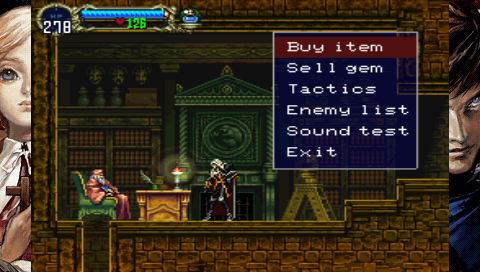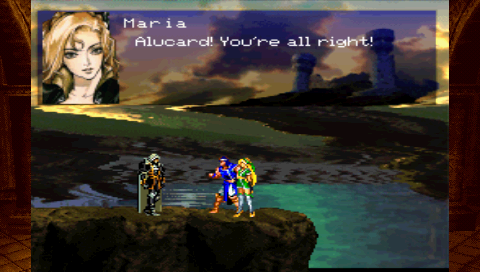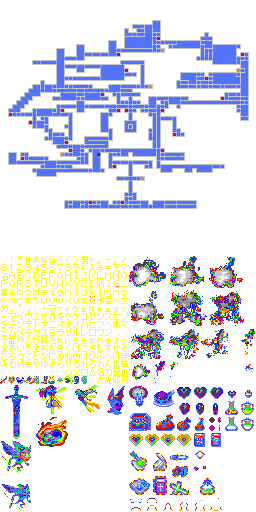Castlevania: The Dracula X Chronicles
| Castlevania: The Dracula X Chronicles |
|---|
|
Also known as: Akumajo Dracula X Chronicle (JP)
|
Castlevania: The Dracula X Chronicles is a 2.5D remake of Castlevania: Rondo of Blood for the PlayStation Portable. It includes the localized version of the original Castlevania: Rondo of Blood and a port of Castlevania: Symphony of the Night, so it quickly becomes the choice of in-depth Castlevania fans.
Contents
Sub-Page
| Prototype Info |
Symphony of the Night Port
Debug Menu
The debug menu can be accessed by pairing a DualShock 3 controller to a PSP Go via Bluetooth, then clicking the R3 button.
The contents and functions of the menu are as follows:
| Debug Option | Explanation |
|---|---|
| GameClearFlag: ON/OFF | Sets whether the player has beat the game before. |
| MutekiFlag: ON/OFF | "Muteki" is Japanese for invincible. This is God-mode. |
| Heart99: ON/OFF | Infinite (always 99) hearts. |
| ScreenMode: 0,1 | 0 is the default screen size, 1 is slightly smaller. |
| PlayWait: 0-6 | Slows the game up to 6 frames. |
| FntPrint: ON/OFF | Displays some information when entering save rooms, though the purpose is not clear. (Needs further investigation.) |
| DrawPolyline: ON/OFF | Shows lines around all polygons and boxes around all sprites. Green color around animated objects, red around static objects. |
| DispSubBuffer: OFF/TEMP/PS/WOLF/ALL | Displays information for loading zones. TEMP displays a picture of the last hallway (loading zone) that was exited. This requires more investigation. |
| GpuEmuInfo: ON/OFF | Displays frame number, additional frame info (does not include frame-rate). |
| CpuGpuTime: ON/OFF | Displays a bar along the top of the screen to (possibly) measure CPU load. |
| OYAJI: 000,001 | "Oyaji" is Japanese for "one's father" or "old man". Possibly to do with Dracula, or the Librarian. |
| AT3: 000-560 | Sound test, with 561 sound clips. Use L and R to skip 20 across. The name of the clip is displayed directly below. |
No-Clip Mode
When using a PSP Go with a DualShock 3 controller paired, the L3 button can be used to enable and disable no-clip mode.
While in no-clip, the player is invincible, and can move through all objects and walls freely. Pressing directional buttons will shift the layer by a few pixels, while holding the X button and moving will speed this up. The Square and Circle buttons are used to cycle through all sprite frames. The Triangle button is used to hide or show the character.
Unused Item Graphics
![]()
Two Book sprites is included alongside the Health and Heart Max Up graphics. One has a hand on the cover and the other has a "?".
![]()
A Rainbow Colored Potion sprite. This could be a Magic Max Up potion, since it is found alongside the Health and Heart Max Up graphics.
![]()
The "Now Make" placeholder graphic from the PlayStation and Saturn versions can still be found in this port's data as well.
- Those sprites can be found in the PSP port while extracting the texture file in realtime as you can see below.
Oddities
This PSP port of SotN is also used in later re-releases including mobile versions. The proof is that you can simply hold left upon entering the room of first Death encounter to leave, such that the whole event (including the scene where Death snatches starting gear) will be skipped. In previous releases you need the "high luck" name to lower defense such that touching a Warg deals more than half of total damage and sends Alucard flying across the room.
Regional Differences
Intro Movie
A scene in the intro movie is omitted in the Japanese version. Strangely, the additional scene is still present in the Japanese promotion movie on the game's official site.
Symphony of the Night Port
Additional Location Names
The Quick Save function in the Japanese version actually follows the player's position when the player enters certain locations that don't have a save point or in-game location name. These include locations such as the Castle Center and Reverse Clock Tower section. Quick Save data shows text strings for the save-point-free locations respectively.
 |
 |

|
| For Reverse Clock Tower section. | For Castle Center section (the area that the battle with Maria occurs). |
For Reverse Castle Center section (the area that the battle with Shaft occurs). |
Clear Bonus
| Japan | US/Europe |
|---|---|
 |
 |
The Master Librarian menu after the player has cleared the game has both a Sound Test and Voice Actor interviews in the Japanese version.
Bug Fixes
Ending
| US | Europe |
|---|---|
 |
 |
Apparently due to a porting oversight, the background in the epilogue scene is displayed incorrectly in Japanese/US versions. This bug is fixed in the European version.
Wing Smash
For some reason, the version of Symphony of the Night included in Dracula X Chronicles uses the Japanese revision 1.0 as a base, resulting in a bug not caught initially by the port's developers; The Wing Smash spell of Alucard's Bat Form, cannot be chained in Japanese revision 1.0.
This bug is present in Japanese and US releases; although it's been fixed in the European version, in the Android and iOS ports of Symphony of the Night (which is based on the Dracula X Chronicles version), if set the game's language to Japanese, this bug is still present!
- Pages missing developer references
- Games developed by Konami
- Games developed by Prosoft Corporation
- Pages missing publisher references
- Games published by Konami
- PlayStation Portable games
- Pages missing date references
- Games released in 2007
- Games released in November
- Games released on November 8
- Games released in October
- Games released on October 23
- Games with debugging functions
- Games with regional differences
- Castlevania series
Cleanup > Pages missing date references
Cleanup > Pages missing developer references
Cleanup > Pages missing publisher references
Games > Games by content > Games with debugging functions
Games > Games by content > Games with regional differences
Games > Games by developer > Games developed by Konami
Games > Games by developer > Games developed by Prosoft Corporation
Games > Games by platform > PlayStation Portable games
Games > Games by publisher > Games published by Konami
Games > Games by release date > Games released in 2007
Games > Games by release date > Games released in November
Games > Games by release date > Games released in November > Games released on November 8
Games > Games by release date > Games released in October
Games > Games by release date > Games released in October > Games released on October 23
Games > Games by series > Castlevania series




